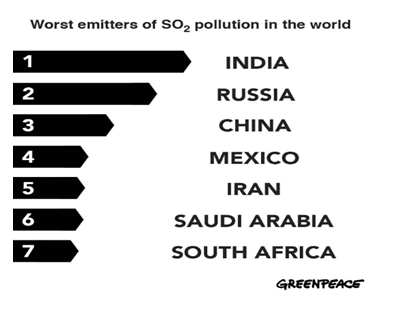India Now Largest Emitter Of Sulphur Dioxide
- 19 Aug 2019
- On 19th August, 2019, environmental NGO Greenpeace released a report according to which India overtook China to become the largest emitter of Sulphur Dioxide (SO2) in the world, contributing more than 15 per cent of global anthropogenic emissions.
- The analysis is based on hotspots detected by NASA’s Ozone Monitoring Instrument (OMI) satellite data that captured more than 500 major source points of SO2 emissions across the globe including natural sources such as volcanoes.
Key Points of the Report
- India was found at the top position in emitting SO2 as it has the maximum hotspots as per the nation-wise rankings.
- Major Hotspots in India: This includes Singrauli (Madhya Pradesh), Neyveli and Chennai (Tamil Nadu), Talcher and Jharsuguda (Odisha), Korba (Chhattisgarh), Kutch (Gujarat), Ramagundam (Telangana) and Chandrapur and Koradi (Maharashtra).
- Hotspots across the Globe: It also highlights other hotspots across the globe, with the Norilsk smelter complex in Russia being the largest SO2 emission hotspot in the world, followed by Kriel in Mpumalanga province in South Africa and Zagros in Iran.
- Individual Hotspots: The Norilsk smelter site in Russia continues to be the largest anthropogenic SO2 emission hotspot in the world, followed by the Kriel area in Mpumalanga province of South Africa, Zagroz in Iran, and Rabigh in Saudi Arabia. Singrauli in Madhya Pradesh is at number five.
 Reasons for India’s Emission
Reasons for India’s Emission
- Expansion of Coal Based Electric Plants:The primary reason for India’s high emission output is the expansion of coal-based electricity generation over the past decade.Five of the top 10 SO2 emission hotspots from coal/power generation industry across the world are in India.
- Lack of Flue-Gas Desulfurization(FGD) Technology: The vast majority of plants in India lack flue-gas desulfurization technology to reduce the pollution from the sulphur.
Flue-Gas Desulfurization( FGD) Plant
|
Impact of Sulphur Emission
Effect on Environment
- When SO2 combines with water and air, it forms sulfuric acid, which is the main component of acid rain.Acid rain can:
- acidify water sourcesaffecting badly the aquatic life
- corrode building materials posing a significant danger to human
- It is absorbed by soils and plants, affecting our land and water ecosystems, and it can even be captured within and below clouds, which increases the chance of acid rain.
- Even small amounts of SO2can harm plants and trees and slow down their growth and development.
- It can form secondary particles (sulphates) that cause haze and reduce visibility.
Effect on Health
- SO2 can cause various health issues which include respiratory problems such as bronchitis, irritation nose, and throat. It has been linked to cardiovascular disease.
- Sensitive groups such as elderly, children or asthmatics will notice strongest symptoms and effects. They are also more susceptible to develop diseases, in case they do not have them yet.
- High concentrations of SO2 in the atmosphere commonly create other sulphur oxides, which reacts with other compounds to form particulate matters(PM). As a result, long-term exposure can seriously damage lungs since PM can penetrate deeply into living organisms.
Government’s Initiative against Sulphur Emission
- The Government in September, 2016, mandated Bharat Stage VI (BS-VI) mass emission standards for various classes of motor vehiclesdirectly from BS-IV norms, throughout the country from April 1, 2020.
- The level of sulphur is the most significant difference between Bharat Stage IV and Bharat Stage VI norms.BS-IV fuels contain 50 parts per million(ppm) sulphur, the BS-VI grade fuel only has 10 ppm sulphur.
- In December 2015, the Ministry of Environment, Forest and Climate Change, had introduced for the first time SO2 emission limits for coal power plants with an initial deadline to retrofit technology to control SO2 emissions from power generation by December 2017.
- However, this was later extended till December 2019 for power plants in Delhi-NCR and till 2022 for some other power plants across the country through a Supreme Court order.
Way Forward
- Of the world’s major emitters, China and the United States have been able to reduce emissions rapidly by switching to clean energy sources. China, in particular, has achieved success by dramatically improving emission standards and enforcement for SO2
- India should accelerate implementation of the emission standards and stop any new investment on coal and move aggressively towards renewable energy sources which are not just environment friendly but are overall sustainable and cheaper than polluting coal.




